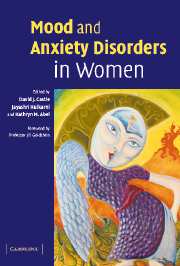Book contents
- Frontmatter
- Contents
- Contributors
- Preface
- Foreword
- 1 Pubertal development and the emergence of the gender gap in mood disorders: A developmental and evolutionary synthesis
- 2 Borderline personality disorder: Sex differences
- 3 Substance use and abuse in women
- 4 Anxiety disorders in women
- 5 Posttraumatic stress disorder in women
- 6 Domestic violence and its impact on mood disorder in women: Implications for mental health workers
- 7 Depression in women: Hormonal influences
- 8 Anxiety and mood disorders in pregnancy and the postpartum period
- 9 Pharmacological treatment of anxiety and depression in pregnancy and lactation
- 10 Bipolar affective disorder: Special issues for women
- 11 Mood and menopause
- 12 Anxiety and depression in women in old age
- Index
1 - Pubertal development and the emergence of the gender gap in mood disorders: A developmental and evolutionary synthesis
Published online by Cambridge University Press: 13 August 2009
- Frontmatter
- Contents
- Contributors
- Preface
- Foreword
- 1 Pubertal development and the emergence of the gender gap in mood disorders: A developmental and evolutionary synthesis
- 2 Borderline personality disorder: Sex differences
- 3 Substance use and abuse in women
- 4 Anxiety disorders in women
- 5 Posttraumatic stress disorder in women
- 6 Domestic violence and its impact on mood disorder in women: Implications for mental health workers
- 7 Depression in women: Hormonal influences
- 8 Anxiety and mood disorders in pregnancy and the postpartum period
- 9 Pharmacological treatment of anxiety and depression in pregnancy and lactation
- 10 Bipolar affective disorder: Special issues for women
- 11 Mood and menopause
- 12 Anxiety and depression in women in old age
- Index
Summary
This book addresses mood and anxiety disorders in women. It takes a broad developmental approach, aimed at understanding and offering appropriate treatment for women with such disorders. The primary aim of this first chapter is to examine the emergence of the gender gap in depressive disorders at puberty, and to compare alternative theories as to the factors that underpin gender differentiation in depression at this developmental stage. These models are synthesised using an evolutionary perspective on gender differences to integrate the insights provided by socialisation, life stress, and biological models of pubertal development. Anxiety and anxiety disorders are addressed only peripherally, given the relative paucity of research in this area.
The emergence of gender differences in affective disorders during adolescence
Perhaps the most robust finding in psychiatric epidemiology is that the rate of unipolar depression is higher among females than it is among males (Weissman et al., 1996). Females are nearly twice as likely as males to experience case-level depression diagnoses (Kessler et al., 1994; McGrath et al., 1990; Nolen-Hoeksema, 1990; Weissman & Klerman, 1977), and this finding holds true across a variety of cultures and racial/ethnic groups (Gater et al., 1998). Furthermore, studies of nonclinical depressed mood states have shown that females experience more symptoms during episodes of depressed mood than do males (Wilhelm et al., 1998).
Keywords
- Type
- Chapter
- Information
- Mood and Anxiety Disorders in Women , pp. 1 - 19Publisher: Cambridge University PressPrint publication year: 2006
- 2
- Cited by

